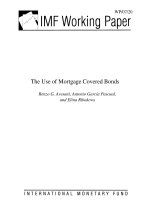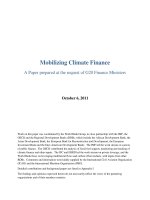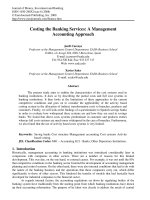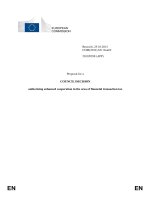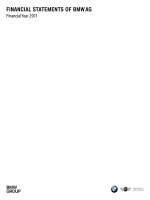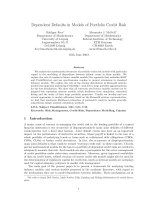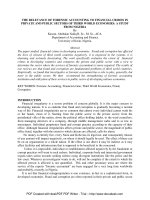Dictionary of 1000 Accounting Terms_3 potx
Bạn đang xem bản rút gọn của tài liệu. Xem và tải ngay bản đầy đủ của tài liệu tại đây (104.92 KB, 20 trang )
/>81
FIXED ASSET TURNOVER measures management's ability to generate
revenues from investments in fixed assets. FAT considers only the firm's
investment in property, plant and equipment and is extremely important in high
asset firms such as manufactures and telecommunications companies.
Generally, the higher this ratio:
the smaller the investment required to generate sales, thus the more
profitable the firm.
indicates the firm has less money tied up in fixed assets for each dollar of
sales revenue.
A declining ratio may indicate that the firm has over-invested in plant, equipment,
or other fixed assets.
FIXED BUDGET is a budget that is not adjusted for changes in the volume of
service. See FLEXIBLE BUDGET.
FIXED CHARGE is those expenses incurred each time a batch of product is
produced. Primarily consists of ordering cost for the raw material, engineering
costs for machine setup and preparation for the production run, and work order
processing cost; also known as SETUP COST.
FIXED CHARGE RATIO is calculated: total fixed costs/total expenses.
FIXED COST is a cost that does not vary depending on production or sales
levels, such as rent, property tax, insurance, or interest expense.
FIXED COSTS are operating expenses that are incurred to provide facilities and
organization that are kept in readiness to do business without regard to actual
volumes of production and sales. Fixed costs remain relatively constant until
changed by managerial decision. Within general limits they do not vary with
business volume. Examples of fixed costs consist of rent, property taxes, and
interest expense.
FIXED FEE is a set price for the completion of a project. It is easier for the
customer to budget, but provides higher risk for the contractor due to cost
overruns.
FIXED OVERHEAD is those costs like rent, utilities, basic telephone, loan
payments, etc., that stay the same whether sales go up or down. Variable
overhead, on the other hand, are those costs which vary directly with production.
FIXED EXPENSES in the operation of a business are those expenses that
remain the same regardless of production or sales volume, i.e. do not fluctuate
with sales volume. Contrast with VARIABLE EXPENSES.
/>82
FLASH REPORT provides highlights of key information promptly to the
responsible managerial accountant; also called EXCEPTION REPORT.
FLAT INTEREST refers to charging interest on the full original loan amount,
rather than on the declining balance. With group based loans, for example, a
common "interest rate" is "3% per month, flat, for 4 months". This means that a
$100 principal amount lent is multiplied by 3%, and then by 4 months to come up
with $12 in interest. Thus, $112 would be repaid over 4 months in equal
installments.
FLAT LEASE is a lease where the cost is fixed for a specific period of time.
FLAT RATE is a per unit price that remains constant regardless of the volume
purchased.
FLEXIBLE BUDGET is based upon different levels of activity. It is a very useful
tool for comparing actual costs experienced to the cost allowable for the activity
level achieved, i.e. it is dynamic in nature as compared to static. A series of
budgets can be readily developed to fit any activity level. Flexible budgeting
distinguishes between fixed and variable cost, thereby allowing for a budget that
can be automatically adjusted to the level of activity actually attained.
FLOAT is 1. the time between the deposit of checks in a bank and when the
amount is truly accessible; 2. the amount of funds represented by checks that
have been written but not yet presented for payment. Some entities will 'play the
float' by writing checks although there are insufficient funds actually on deposit to
cover the checks; and, 3. to issue new securities through an underwriter.
FLP is Family Limited Partnership.
FMR see FINANCING MARGIN RATIO.
FOOTING, in accounting, is the sum of a column of figures.
F.O.B. (FREE ON BOARD) is a transportation term that indicates that the price
for goods includes delivery at the seller’s expense to a specified point and no
further. The FOB term is used with an identified physical location to determine 1)
the responsibility and basis for payment of freight charges, and 2) the point a
twhich title for the shipment passes from seller to buyer.The FOB location terms,
Origin and Destination, may be qualified by modifiers. The modifier determines
the payment of the transportation charges. Modifiers denote nothing about the
title of the goods or filing of claims. The most three common modifiers are:
Collect, Prepaid & Add, and Prepaid & Allow. Collect: The carrier collects the
transportation charges from the buyer. Prepaid & Add: The seller prepays the
transportation charges, but adds the charges to the invoice for reimbursement
/>83
from the buyer .Prepaid & Allow: The seller prepays the transportation charges
and they are already included in the contract price.
F.O.B. DESTINATION is where the seller retains title and control of goods until
they are delivered and the contract of carriage has been completed. The seller
selects the carrier and is responsible for the risk of transportation.
FOB POINT OF ORIGIN is where the supplier is responsible for all shipping
costs to the point of having the goods loaded unto the vessel for shipment to its
destination. The purchaser, from that point forward, is responsible for all further
shipping costs to the point of destination, e.g., insurance, transportation, etc.
FOLIO, dependent upon application, is a. a book (or manuscript) consisting of
large sheets of paper folded in the middle to make two leaves or four pages; or,
b. a sheet of any written or printed material (especially in a manuscript or book);
or, c. the system of numbering pages; or, d. in investments, an unstructured
basket of common stock that may represent a stock index, a sector or theme, or
even an actively-managed portfolio at inception, but which may be modified by
an investor or an advisor to meet the tax and spending needs of its owner. The
rationale for the folio is to take advantage of diversification and the ability to
realize tax losses in a separately managed account. In general, an investor will
have to devote a fair amount of time to the folio or engage the services of a
specialized advisor.
FOOTING is the sum of a column of figures.
F.O.R. (FREE ON RAILROAD) is where goods will be delivered by the exporter
to a railway station. The importer is responsible from this point on.
FORECAST is to estimate or calculate expected business results in advance. To
plan the business course for the future. A document that sets down the plan. See
BUSINESS PLAN, PROJECTION, BUDGET.
FOREIGN CURRENCY TRANSLATION is the process of restating foreign
currency accounts of subsidiaries into the reporting currency of the parent
company in order to prepare consolidated financial statements in the native
currency of the parent company.
FOREIGN SALES AGENT or REPRESENTATIVE is an entity that works to sell
your merchandise in a foreign country. Equivalent to the “Manufacturer's
Representative” in the U.S.
FORENSIC ACCOUNTING provides for an accounting analysis that is suitable to
a court of law which will form the basis for discussion, debate and ultimately
dispute resolution. Forensic accounting encompasses investigative accounting
and litigation support. Forensic accountants utilize accounting, auditing and
/>84
investigative skills when conducting an investigation. Equally critical is the ability
to respond immediately and to communicate financial information clearly and
concisely in a courtroom setting.
FORM 1065 (Schedule K-1) is the domestic partnership income tax return form
used in the U.S.
FORM 1120 is the income tax return form used by corporations in the U.S.
FORESEEABLE is what may be reasonably anticipated.
FORWARD LOOKING STATEMENTS, within the meaning of the U.S. Private
Securities Litigation Reform Act of 1995,
are statements made that are not historic and are thereby predictive. You can
identify forward-looking statements by use of the words “believe”, “expect”,
“anticipate”, “intend”, “estimate”, “assume”, “project” and other similar
expressions that predict or indicate future events and trends or that do not relate
to historical matters. Such forward-looking statements involve known and
unknown risks, uncertainties and other factors which may cause actual results,
performance or achievements to be materially different from any future results,
performance or achievements expressed or implied by such forward-looking
statements.
FORWARD PREMIUM is when a currency trade forward price is higher than its
spot price.
FP, among others, means Fixed Price.
FRANCHISE is a legal arrangement giving rights to sell a product or service.
FRAUD is intentional deception resulting in injury to another person or entity
FREE CASH FLOW is net income plus non-cash charges to income, specifically
depreciation and amortization less capital expenditures, to sustain the basic
business.
FREE TRADE AGREEMENT is an agreement between countries that will result,
over an agreed period of time, in an elimination of duties for goods flowing
between the signatories.
FREE TRADE ZONE (FTZ) is an area, usually a port of entry, designated by the
country for duty-free entry of goods. As long as the goods do not go into the
country from the FTZ, no duty is assessed. While in the FTZ, goods may be
processed, packaged, serviced or displayed.
/>85
FREIGHT FORWARDER is an individual or firm that provides for the packing
and shipping of merchandise. Generally they also assist with export and other
documentation.
FRIENDLY TAKEOVER consists of a straight buyout of a company, and
happens all the time. The shareholders receive cash or (more commonly) an
agreed-upon number of shares of the acquiring company's stock.
FREQUENCY, in advertising, is the number of times you hope to reach your
target audience through your advertising campaign.
FRF is an acronym for French Francs.
FRR see FINANCIAL REPORTING RELEASE.
FRS 19, in the UK, is a deferred tax standard. In summary:
A. Deferred tax is provided on timing differences relating to:
- accelerated capital allowances and depreciation
- accruals for and payments of pension and other post retirement benefits
- the elimination of unrealized intra group profits
- unrelieved tax losses
- “fair value revaluations” that are taken annually to the profit and loss account
- other short-term timing differences
B. Deferred tax is not provided on timing differences relating to:
- other fixed asset revaluations, where there is no intention to sell
- gains that are rolled over
- unremitted overseas earnings, where there is no intention to remit.
The FRS 19 Standard also includes further, detailed measurement and
disclosure rules.
FSA has several possible meanings, e.g. Flexible Spending Account (employee
benefit offered by some companies) or Funding Standard Account.
FULL CHARGE BOOKKEEPER is someone who can do it all - including
compiling the data into the General Ledger and preparing financial statements.
FULL COSTING see ABSORPTION COSTING.
FULL COST RECOVERY is adjusting fees/prices for goods/services to where all
cost of operations and maintenance are covered for supplying the given goods or
services.
FULL DISCLOSURE, generally, is the requirement to disclose all relevant or
material facts to a transaction.
/>86
FULLY DEPRECIATED is when an asset has already been charged with the
maximum amount of depreciation allowed by the taxing authority for accounting
purposes.
FUND is a pool of money normally set apart for a purpose, for example, a
pension fund to provide pensions.
FUND ACCOUNTING is a method of accounting and presentation whereby
assets and liabilities are grouped according to the purpose for which they are to
be used. Generally used by government entities and not-for-profits.
FUNDAMENTAL ANALYSIS is a method used to evaluate the worth of a
security by studying the financial data of the issuer. Performing fundamental
analysis will teach you a lot about a company, but virtually nothing about how it
will perform in the stock market. Apply this analysis on two competing companies
or in comparisone to its industry and it becomes clearer which the best
investment choice is. See FUNDAMENTALS.
FUNDAMENTALS are factors which are “fundamental” to the working of a
company’s business, its profitability, operating costs, product prices, technical
innovations, etc. Company analysis taking into account these fundamental
factors facilitates share valuation. See FUNDAMENTAL ANALYSIS.
FUNDED DEPRECIATION ACCOUNT is a reserve setup to cover the
replacement cost of those capital assets covered within the depreciation
schedule.
FUND MANAGEMENT is the professional, in many cases regulated, caretaker of
client assets for a fee. Dependent upon type of fund, the fund may be authorized
to put assets within the fund at risk in the pursuit of profits for the asset owners
(clients).
FUNDS FLOW is the funds generated from operations; normally expressed as
'cash flow from operations' or 'working capital from operations'.
FUTA see FEDERAL UNEMPLOYMENT TAX ACT.
FUTURE VALUE is the amount of money that an investment made today (the
present value) will grow to by some future date. Since money has time value, we
naturally expect the future value to be greater than the present value. The
difference between the two depends on the number of compounding periods
involved and the going interest rate.
FX ACCOUNT (Foreign Exchange Account) is a trading account usually based in
foreign currencies.
/>87
FYE is For Year Ending.
/>88
GAAP see GENERALLY ACCEPTED ACCOUNTING PRINCIPLES.
G&A usually refers to the indirect overhead costs contained within the General
and Administrative expense / cost categories (see also SG&A).
GAI is Guaranteed Annual Income.
GAO see GENERAL ACCOUNTING OFFICE.
GARBAGE IN, GARBAGE OUT (GIGO) is an often used computer and software
industry saying meaning that if the data going into a system is suspect, the
resulting data output will be suspect.
GASB stands for Government Accounting Standards Board.The GASB is a
nonprofit organization responsible for establishing and improving accounting and
financial reporting standards for governmental units.
GATT (GENERAL AGREEMENT ON TARIFFS AND TRADE) is a multilateral
treaty that aims to reduce trade barriers and increase trade. The GATT was an
interim treaty process that has now culminated in the World Trade Organization
(WTO).
GBP is United Kingdom Pound Sterling (Currency Code).
GDP see GROSS DOMESTIC PRODUCT.
GEARING is the proportion of the capital employed of a company that is financed
by lenders rather than shareholders.
GEARING RATIO measures the percentage of capital employed that is financed
by debt and long term financing. The higher the gearing, the higher the
dependence on borrowing and long term financing. Whereas, the lower the
gearing ratio, the higher the dependence on equity financing. Traditionally, the
higher the level of gearing, the higher the level of financial risk due to the
increased volatility of profits. Financial manager face a difficult dilemma. Most
businesses require long term debt in order to finance growth, as equity financing
is rarely sufficient, on the other hand, the introduction of debt and gearing
increases financial risk. A high gearing ratio is positive; a large amount of debt
will give higher return on capital employed but the company dependent on equity
financing alone is unable to sustain growth. Gearing can be quite high for small
businesses trying to become established, but in general they should not be
higher than 50%. Shareholders benefit from gearing to the extent that return on
the borrowed money exceeds the interest cost so that the market value of their
shares rise.
/>89
GENERAL ACCOUNTING involves the basic principles, concepts and
accounting practice, recording, financial statement preparation, and the use of
accounting information in management.
GENERAL ACCOUNTING OFFICE (GAO) is the organization in the U.S.
Congress that investigates the performance of the federal government. GAO
evaluates the use of public funds and the performance of federal programs, while
also providing analytical, investigative and legal services in order to support to
Congress in its policy formulation and decision making processes. Most GAO
reports are initiated at the request of Congress, while some are initiated by the
agency itself or are required by law.
GENERAL EXPENSE is expense not directly connected with any single
department.
GENERAL JOURNAL is the most basic of journals. It is a chronological list of
transactions. It has a very specific format for recording each transaction. Each
transaction is recorded separately and consists of: 1.) a date; 2.) any and all
accounts to receive a debit entry are listed first with an amount in the appropriate
column, then; 3.) any and all accounts to receive a credit entry are indented and
listed next with an amount in the appropriate column; 4.) a clear description of
the transaction. At least one line is then skipped to visually separate recorded
transactions.
GENERAL LEDGER is the record of all account entries.
GENERALLY ACCEPTED ACCOUNTING PRINCIPLES (GAAP) is a
recognized common set of accounting principles, standards, and procedures.
GAAP is a combination of accepted methods of doing accounting and policy
board set authoritative standards.
GENERALLY ACCEPTED AUDITING STANDARDS (GAAS), in the US, are the
broad rules and guidelines set down by the Auditing Standards Board of the
American Institute of Certified Public Accountants (AICPA). In carrying out work
for a client, a certified public accountant would apply the generally accepted
accounting principles (GAAP); if they fail to do so, they can be held to be in
violation of the AICPA's code of professional ethics.
GENERAL LEDGER is the accounting records that show all the financial
statement accounts of a business.
GENERAL PARTNERSHIP is one or more partners who are jointly and severally
responsible or liable for the debts of the partnership.
GEOGRAPHICAL SEGMENT is a component of an enterprise that (a) provides
products and services within a particular economic environment and (b) that is
/>90
subject to risks and returns that are different from those of components operating
in other economic environments.
GFOA is Government Finance Officers' Association.
GILT is a bond issued by the UK government. Gilts are equivalent to a U.S.
Treasury security.
GLOBAL CUSTODY is a term used within the investment banking industry in
defining securities/monetary instruments that are traded internationally by Global
Custodians. Those securities would be held in "Global Custody". Chase Bank
originated the concept of providing Global Custody trading services for
institutional investors trading in foreign markets in 1974. Banks recognized as
Global Custodians provide their customers with Global Custody services in
respect to securities traded and settled not only in the country in which the Global
Custodian is located but also in numerous other countries throughout the world.
GLOBAL DEPOSITORY RECEIPTS are receipts evidencing ownership in the
underlying shares of a foreign company. Generally, U.S. banks and trusts issue
American depository receipts (ADR) and American depository shares (ADS).
They hold the foreign company securities underlying the receipts in their vaults.
In addition to the underlying securities, the receipts entitle the shareholder to all
dividends and capital gains. The bank or trust company issuing the receipts may
have denominated the receipts in a currency other than the currency underlying
the foreign security. U.S. and European banks and trust companies usually issue
global depository receipts (GDR), which are receipts in the shares of global
offering of a foreign issuer who has issued two securities simultaneously in two
markets, usually publicly in non-U.S. markets and privately in the U.S. market.
European banks and trust companies generally issue European depository
receipts (EDR), sometimes called continental depository receipts (CDR) when
issued in bearer form, which evidence ownership in foreign securities.
GLOBAL MUTUAL FUND, also Bond Fund, is a mutual fund that can invest in
stocks and bonds throughout the world. Such funds typically have a portion of
their assets in American markets as well as Europe, Asia, and developing
countries. Global funds differ from INTERNATIONAL MUTUAL FUNDS, which
invest only in non-Canadian securities. The advantage of global funds is that the
fund managers can buy stocks or bonds anywhere they think has the best
opportunities for high returns. Thus if one market is underperforming, they can
shift assets to markets with better potential. Though some global funds invest in
both stocks and bonds, most funds specialize in either stocks or bonds.
GMP is either Good Manufacturing Practice(s) or Gross Maximum Price.
GMROI is an acronym for Gross Margin Return On Investment (retail).
/>91
GNP see GROSS NATIONAL PRODUCT.
GOAL is the milestone the organization aims to achieve that evolves from the
strategic issues. They transform strategic issues into specific performance
targets that impact the entire organization. They can be qualitative or
quantitative. Dependent upon usage, GOALS are general in nature, while
OBJECTIVES are specific, measurable and time-based. In some organizations,
the meanings for GOAL and OBJECTIVE are reversed.
GOING CONCERN refers to the liquidity of a concern. If the concern is illiquid,
the viability of that concern being able to continue to operate is in doubt.
GOING CONCERN CONCEPT is the underlying assumption that any accountant
makes when he prepares a set of accounts. That the business under
consideration will remain in existence for the foreseeable future.
GOING CONCERN PRINCIPLE assumes that the accounting entity will maintain
proper accounting records from the date of its establishment to the date of its
liquidation.
GOING PUBLIC refers to those activities that relate to offering a private
company's shares to the general investing public including registering with the
SEC.
GOING RATE is an expression that means the cost of the average of suppliers
of like products or services. The connotation is that the cost will be "no more
expensive than the competition."
GOLDEN RULES OF ACCOUNTING are: 1. Debits ALWAYS EQUAL Credits; 2.
Increases DO NOT NECESSARILY EQUAL Decreases; and, 3. Assets -
Liabilities = Owner's Equity (The Accounting Equation).
GOODWILL is that intangible possession which enables a business to continue
to earn a profit that is in excess of the normal or basic rate of profit earned by
other businesses of similar type. The goodwill of a business may be due to a
particularly favorable location, its reputation in the community, or the quality of its
employer and employees. The evidence that goodwill exists is the proven ability
to earn excess profits. Goodwill is created on the books of a newly purchased
company to the extent that the purchase price of the company is greater than the
value of its net tangible assets.
GRANTEE is the person or entity to whom property or assets are transferred.
GRANTOR is the person or entity who transfers property or assets.
/>92
GREEN BOOK is a publication entitled U.S. Overseas Loans and Grants and
Assistance from International Organizations. This data, which is grouped by
country and geographic region, includes assistance from USAID, military
assistance, P.L. 480, Export-Import Bank, etc. from 1945 to the last completed
fiscal year This publication is released shortly after the Congressional
Presentation is distributed.
GROSS is: a. the entire amount of income before any deductions are made; or,
b. any total amount before any deductions (examples: gross income or gross
labor).
GROSS CONTRIBUTION is the starting amount prior to any relevant deductions
have been made to the gross amount, e.g., Gross Contribution to Margin.
GROSS DOMESTIC PRODUCT (GDP) is the value of all the goods and services
produced by workers and capital located within a country (or region), such as the
United States, regardless of nationality of workers or ownership. Domestic
measures relate to the physical location of the factors of production; they refer to
production attributable to all labor and property located in a country. The national
measures differ from the domestic measures by the net inflow that is, inflow
less outflow of labor and property incomes from abroad. Gross Domestic
Product includes production within national borders regardless of whether the
labor and property inputs are domestically or foreign owned.
GROSS MARGIN is the ratio of gross profit to sales revenue. (sometimes used
as a synonym for gross profit). For a manufacturer, gross margin is a measure of
a company's efficiency in turning raw materials into income; for a retailer it
measures their markup over wholesale. GROSS MARGIN is gross income
divided by net sales, expressed as a percentage.
GROSS NATIONAL PRODUCT (GNP) is the total dollar value of all final goods
and services produced for consumption in society during a particular time period.
The GNP does include allowances for depreciation and indirect business taxes
such as those on sales and property. Gross national product is the output of
labor and property of US nationals regardless of the location of the labor and
property. Gross National Product includes income earned by the factors of
production (assets and labor) owned by a country's residents but excludes
income produced within the country's borders by factors of production owned by
nonresidents.
GROSS NEGLIGENCE is any action or an omission in reckless disregard of the
consequences to the safety or property of another. Sometimes referred to as
"very great negligence" and it is more then just neglect of ordinary care towards
others or just inadvertence. Also known as the Latin term culpa lata.
/>93
GROSS PAY is employee salary prior to the application of taxes and other
deductions.
GROSS PROFIT is net sales minus cost of sales.
GROSS PROFIT MARGIN ON SALES (GPM) is one of the key performance
indicators. The gross profit margin gives an indication on whether the average
markup on goods and services is sufficient to cover expenses and make a profit.
GPM shows the relationship between sales and the direct cost of
products/services sold. It measures the ability of both to control costs and to pass
along price increases through sales to customers. The gross profit margin should
be stable over time. A persistent gradual decrease is likely to indicate that
productivity needs to be increased to return profitability back to previous levels.
GROSS PROFIT METHOD is an inventory estimate based on gross margin.
GROSS RECEIPTS is the total amount received prior to the deduction of any
allowances, discounts, credits, etc.
GROSS REVENUE is income (at invoice values) received for goods and services
over some given period of time. See also GROSS SALES.
GROSS SALES is the total revenue at invoice value prior to any discounts or
allowances. See also GROSS REVENUE.
GROSS WEIGHT is the weight of a shipment including packing material.
GROUP is a number of individual companies assembled together; often having
some unifying relationship.
GROUP ACCOUNTS are the financial statements of a group of companies.
These are usually presented in the form of consolidated accounts.
GUARANTEE see WARRANTY
/>94
HARD COSTS is the purchase price of actual assets. For example, the purchase
price of a new printing press would be the hard cost. The soft costs are additional
fees for items like factoring-invoiced installation, prepaid and extended
warranties, or service contracts for the new equipment.
HARMONIZED SYSTEM is an internationally agreed upon classification system
for trade. It provides code numbers to specify a goods classification; thereby
making customs duty determination more predictable.
HEADCOUNT is the act of counting people in a certain way or in a particular
group.
HEAD OF HOUSEHOLD is a U.S. income tax filing status that can be used by
an unmarried person who maintains a home for a dependent (or nondependent
relative) during the tax year.
HEDGE, in securities, is a transaction that reduces the risk of an investment.
HEDGE FUND is a special type of investment fund with fewer restrictions on the
types of investments it can make. Of note is a hedge fund's ability to sell short. In
exchange for the ability to use more aggressive strategies, hedge funds are more
exclusive, i.e., fewer people, usually only the wealthy, are allowed to invest in
hedge funds.
HEDGING, in securities, is taking two positions that will offset each other if prices
change, thereby limiting financial risk.
HELD TO MATURITY normally refers to a long term security (note or bond held
for more than one year) that has a predetermined maturation event.
HIDDEN ASSET is any valued asset that is not included in the book value of a
company. Companies have hidden assets such as intellectual property, or
customer lists which are of great value, but not reflected in the book value.
HIGH-LOW METHOD is an algebraic procedure used to separate a semi-
variable cost into the variable and fixed components. The method calls for using
the extreme data points (highest and lowest x - y pairs) in the COST-VOLUME
FORMULA y = a + bx; where a = fixed cost portion and b = the variable rate.
HIRE AND PURCHASE AGREEMENT is a contract (more fully called contract of
hire with an option of purchase) in which a person hires goods for a specified
period and at a fixed rent, with the added condition that if he shall retain the
goods for the full period and pay all the installments of rent as they become due
the contract shall determine and the title vest absolutely in him, and that if he
chooses he may at any time during the term surrender the goods and be quit of
any liability for future installments upon the contract. In the United States such a
/>95
contract is generally treated as a conditional sale, and the term hire purchase is
also sometimes applied to a contract in which the hirer is not free to avoid future
liability by surrender of the goods. In England, however, if the hirer does not have
this right the contract is a sale.
HISTORICAL COST ACCOUNTING is an accounting principle requiring all
financial statement items to be based on original cost. It is usually based upon
the dollar amount originally exchanged in an arm's-length transaction; an amount
assumed to reflect the fair market value of an item at the transaction date.
HOLDING COMPANY is a company which owns or controls other companies.
(Control can occur through the ownership of 50 per cent or more of the voting
rights or through the exercise of a dominant influence.)
HORIZONTAL FINANCIAL ANALYSIS allows comparison of one company's
ratios to the ratios of other companies as well as to average industrial ratios and
internal industrial deviation of these ratios.
HOSTILE TAKEOVER occurs when a company attempts to buy out another
whether they like it or not. A hostile takeover can occur only through publicly
traded shares, as it requires the acquirer to bypass the board of directors and
purchase the shares from other sources. This is difficult unless the shares of the
target company are widely available and easily purchased (i.e., they have high
liquidity). A hostile takeover may presage a corporate raid.
HUMAN CAPITAL is the unique capabilities and expertise of individuals that are
productive in some economic context.
HURDLE RATE is a term used in the budgeting of capital expenditures meaning
the REQUIRED RATE OF RETURN in a DISCOUNTED CASH FLOW analysis.
If the expected rate of return on an investment is below the hurdle rate, the
project is not undertaken. The hurdle rate should be equal to the INCREMENTAL
COST OF CAPITAL.
HYBRID INSTRUMENT is a package containing two or more different kinds of
risk management instruments that are usually interactive.
HYPOTHECATION, in securities, is the pledging of securities to brokers as
collateral for loans made to cover short sales or purchase securities. In banking,
it is the pledging of property to secure a loan.
/>96
IBA, among others, can mean: Individual Brokerage Account, Individually Billed
Accounts, Institute of Business Appraisers, International Bar Association, or,
International Business Advisors.
IBNR is Incurred But Not Reported.
IDENTIFIABLE ASSETS and LIABILITIES are those assets and liabilities of a
business that can be disposed of without disposing of the entire business. It
includes both tangible and intangible assets.
IMA, in accounting, refers to the Institute of Management Accountants.
IMMATERIALITY is of complete irrelevance requiring no further consideration.
IMPAIRED ASSETS, in banking, applies to all problem assets which banks hold,
and is not limited to problem loans. In addition to loans, it also captures off-
balance sheet exposures and assets which have come onto banks balance
sheets through enforcement of security conditions. See IMPAIRMENT OF
VALUE.
IMPAIRED GOODWILL is the recognition of the reduction in value of the
intangible asset known as goodwill.
IMPAIRMENT OF VALUE is the permanent decline in the value of an asset. The
entry is to debit the loss account and credit the asset for the loss in utility. See
IMPAIRED ASSETS.
IMPOSTA VALORE AGGIUNTO TAX (IVA TAX), in Italy, like most other
European countries, Italy imposes a value added tax (VAT) on most goods and
services purchased in the country. In Italy, the value added tax is known as the
Imposta sul Valore Aggiunto or IVA. This tax is normally included or built into the
price of most goods and services. The general rate of tax is 19% of the sale
price.
IMPREST see PETTY CASH
IMPUTED COSTS refer to the cost of an asset, service, or company that is not
physically recorded in any accounts but is implicit in the product.
IMPUTED VALUE is the logical or implicit value that is not recorded in any
accounts, e.g., in the projection of annual figures, values are imputed for months
for which the actual values are not yet known.
INBR see INCURRED BUT NOT REPORTED; could also mean Insurance
Broker.
/>97
INCOME is money received by a person or organization because of effort (work),
or from return on investments.
INCOME CAPITALIZATION: First you must determine the capitalization rate - a
rate of return required to take on the risk of operating the business (the riskier the
business, the higher the required return). Earnings are then divided by that
capitalization rate. The earnings figure to be capitalized should be one that
reflects the true nature of the business, such as the last three years average,
current year or projected year. When determining a capitalization rate you should
compare with rates available to similarly risky investments.
INCOME GEARING RATIO is Interest Expense / Operating Profit.
INCOME STATEMENT see PROFIT AND LOSS STATEMENT.
INCOME TAXES PAYABLE is income taxes due including current portion of
deferred taxes.
INCOME THEORIES try to identify the real profit of an organization. The difficulty
here is that you need to define whose income you are measuring, and that
limiting income measurements to things that can be given a price devalues
goods and services that are difficult or impossible to price.
INCREMENTAL COST is the increase or decrease in costs as a result of one
more or one less unit of output.
INCREMENTAL COST OF CAPITAL is the weighted cost of the additional
capital raised in a given period. Weighted cost of capital, also called composite
cost of capital, is the weighted average of costs applicable to the issues of debt
and classes of equity that compose the firm’s capital structure. Also called
marginal cost of capital.
INCUR is acquiring or getting into something undesirable. In business it usually is
referencing a liability, e.g., incurring a loss or to incur a debt.
INCURRED BUT NOT REPORTED (IBNR), in insurance, losses occurring over
a specified period that have not been reported to the insurer. IBNR losses are
often calculated as a percentage of claims paid and claims outstanding and are
reported in an insurer's annual report. Reinsurers establish IBNR reserves as a
part of their rating plans under a facultative reinsurance treaty, lest an overly
optimistic view of treaty results lead to further under-rating on a book of business.
Example: Product liability losses are seldom reported during a policy year. This
"tail" of claims will upset any rating plan, unless an IBNR reserve is established
and factored into the profit picture.
/>98
INDEFEASIBLE not liable to being annulled or voided or undone, usually in
reference to an interest in real property (e.g., an indefeasible ownership interest
in a piece of property).
INDENTURE is an agreement between lender and borrower which details
specific terms of the bond issuance. Specifies legal obligations of bond issuer
and rights of bondholders. There is usually a indenture document spelling out the
specific terms of a bond as well as the rights and responsibilities of both the
issuer of the security and the holder.
INDIRECT COST is that portion of cost that is indirectly expended in providing a
product or service for sale (cannot be traced to a given cost object in an
economically feasible manner) and is included in the calculation of COST OF
GOODS SOLD, e.g. rent, utilities, equipment maintenance, etc. Opposite of
direct cost.
INDUCTIVE ACCOUNTING THEORY (scientific method) assumes accounting
standards are somewhat like evolution of a species in nature survival of the
fittest. It relies heavily upon controlled experimentation (e.g., behavioral
accounting research) and statistical testing (e.g., capital markets "events" studies
of the impact of accounting information on market prices and volume of
transactions).
INDUSTRIAL REVENUE BOND (I.R.B.) is a bond issued by local government
agencies in favor of corporations.
INDUSTRY ANALYSIS includes, but is not limited to: a. Definition of the industry;
b. Industry Life Cycle - growth, maturity or decline; c. Industry History - how old is
the industry; d. In-depth historical financial performance ratio analysis; e. Industry
Trends - cyclical or seasonal, increased competition etc.; f. Industry Influential
Factors - does economy, government, or competition effect industry; g. Primary
Competitors along with entry risk and barriers to entry; and, h. Projected Industry
Sales - total sales in the industry.
INFLATION is an increase in the general price level of goods and services;
alternatively, a decrease in the purchasing power of the dollar or other currency.
INFLATION ACCOUNTING is a system of accounting which, unlike historical
cost accounting, takes into account changing prices.
INFLATION ADJUSTMENT is whenever any figure is adjusted for
inflation/deflation. It simply means that all fluctuations in price (upward or
downward) that are directly attributable to inflation/deflation are reflected into that
figure through either adding or subtracting the amount that is directly caused by
inflation/deflation.
/>99
INFORMATION / INFORMATIONAL RETURN is one of many returns that only
communicates to the Internal Revenue Service information relevant to tax liability
and does not compute the actual liability of any taxpayer or accompany the
actual payment of tax; used for sale of property, dividends, and others (e.g., W-2
and Forms 1099).
INFORMATION THEORY is a branch of mathematics that overlaps into
communications engineering, biology, medical science, sociology, and
psychology. The theory is devoted to the discovery and exploration of
mathematical laws that govern the behavior of data as it is transferred, stored, or
retrieved.
INFRASTRUCTURE is the resources (as personnel, buildings, or equipment)
required for an activity.
INITIATE is to set going by taking the first step, e.g., initiate contract
negotiations.
IN-KIND is the value of goods or services provided for which money would have
otherwise been paid.
INSIDER TRADING is the trading, primarily of securities, by management or
others who have special access to unpublished information. If the information is
used to illegally make a profit, there may be large fines and possible jail
sentences.
INSOLVENCY occurs when a business is unable to pay debts as they fall due.
INSTALLEMENT AGREEMENT see INSTALLMENT SALE.
INSTALLMENT SALE is selling property and receiving the sales price over a
series of payments, instead of all at once at the close of the sale, is an
installment sale. As the seller, unless you elect out, you will report the gain on
that transaction as you receive it through the series of payments. As the buyer,
you will usually pay interest on the unpaid balance.
INSURANCE CLAIM is a written notification to an insurance company requesting
payment of an amount due under the terms of the policy.
INTANGIBLE ASSET is an asset that is not physical in nature. Examples are
things like copyrights, patents, intellectual property, or goodwill. An intangible
asset is the opposite of tangible asset.
INTANGIBLES (NET) are intangible assets, including goodwill, trademarks,
patents, catalogs, brands, copyrights, formulas, franchises, and mailing lists, net
of accumulated amortization.
/>100
INTEGRATED FINANCIAL MODEL is normally a spreadsheet based financial
model that integrates all projected revenues and costs from all activity into
financial performance pro-forma projections over time. Dependent upon the
complexity of the model, the output can be at a very high level (non-complex) to
highly granular output (higher degree of complexity).
INTEGRATED LEDGER see ENTERPRISE RESOURCE PLANNING.
INTELLECTUAL CAPITAL Intellectual capital bundles knowledge resources
(how the ‘production functions”, that is the constellation of employees, users,
processes and technologies, work). Intellectual capital enables a company to
make a difference to users via its knowledge resources.
INTELLECTUAL CAPITAL STATEMENT (ICS) provides: a. Insights into the
user’s situation (= the customers situation); b. Insight into the colleague’s skills
and improvements of teamwork; c. Insight in the practical skills e.g.
craftsmanship: from knowing how to develop and improve production methods to
be capable of handling information technology etc.; d. Insights in the know-how
represented in the company’s processes and systems and how these can be
used to improve the quality of products or services; e. Insight in the motivation or
commitment as regards the further development of the company’s products and
services; f. Insight in the future needs for knowledge; g. Insight in the skills,
competencies and qualification that can make a difference to the company.
INTENSITY DRIVERS are used to directly charge for the resources used each
time an activity is performed.
INTERCOMPANY means occurring between companies.
INTEREST, in law, is a right or legal share of something or a financial
involvement with something; in finance, it is a fixed charge for borrowing money;
usually a percentage of the amount borrowed.
INTEREST-BEARING means paying interest.
INTERESTED PARTY is any person that has a real and direct interest in any
proceeding or action being proposed or taken.
INTEREST EXPENSE is the cost of borrowing funds in the current period. It is
shown as a financial expense item within the income statement.
INTEREST RATE is the rate of interest charged for the use of money, usually
expressed as an annual rate. The rate is derived by dividing the amount of
interest by the amount of principal borrowed. For example, if a bank charged
$100 a year to borrow $1,000, the interest rate would be 10%. Interest rates are
quoted on bills, notes, bonds, credit cards and many kinds of consumer and

